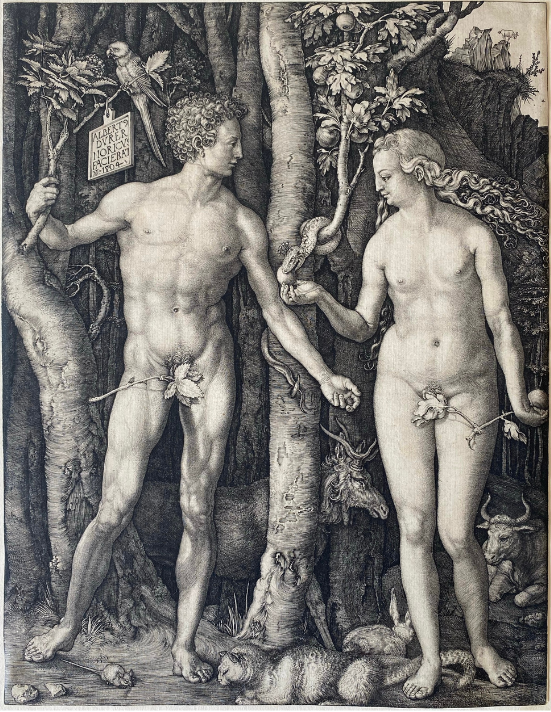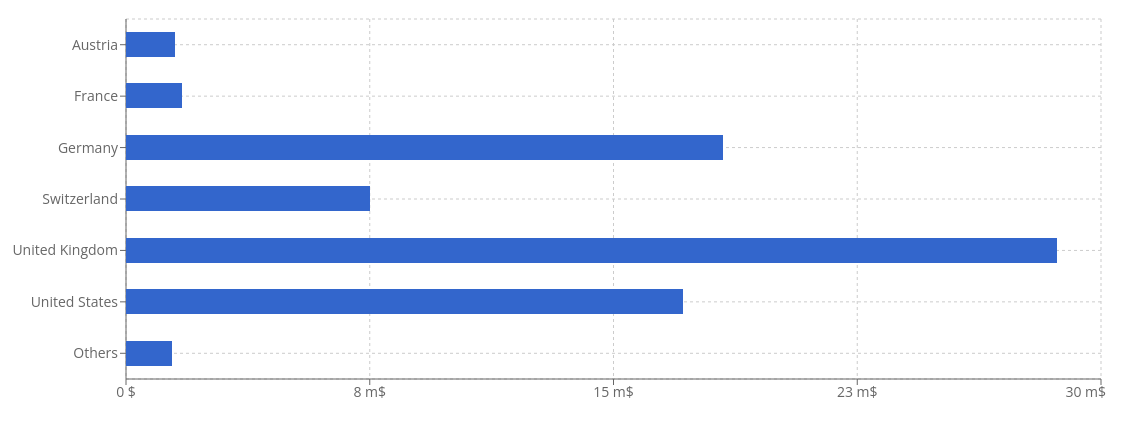An exceptional print by Albrecht Dürer on sale in Paris
[16 Jun 2023]Extremely rare on the international art market, a superb third-state print of Albrecht Dürer’s Adam and Eve is about to hit the Parisian auction market. A first for decades for the French art market.
Estimated between $130,000 and $160,000, the Bible’s ‘first couple’ engraved by DÜRER’s goldsmith hands will be offered on 23 June by Tessier & Sarrou in Paris, and should attract interest from major international print collectors. A 16th century visionary artist from Nuremberg, Dürer’s place in the history of printmaking is unique as he is credited with having literally put engraving on Art History’s map. In his era the practice was both rare and marginal, but he exploited all of its possibilities with intelligence and strategy, establishing not just his own legendary fame, but also that of the medium.
An absolute masterpiece by the “Genius of the North”, this Adam and Eve print is the first in a series of four intended to represent the four stages of existence from birth to old age. It was produced in 1504. The other three were produced later: 1513 for The Knight, Death and the Devil; and 1514 for La Melencolia and Saint Jerome in his cell.
Dürer’s ‘temptation’ at Tessier & Sarrou
Adam and Eve stands out in Dürer’s printed work as one of his most complex images and illustrates all the technical virtuosity of the German engraver. The artist “reinvented” Adam and Eve for his Renaissance audience, physically and temporally transporting the couple from the Garden of Eden to a wild Germanic forest. Against a background that is disturbingly full of trees and impenetrable foliage, the bodies seem surprisingly at ease in their nudity. In contrapposto, they recall the classical statues of Venus and Apollo (Belvedere version) that Dürer had recently discovered during first trip to Italy.

Albrecht Dürer, Adam & Eve , 1504. Chisel copper engraving, 248 × 191 mm
Estimate: €120,000 – €150,000 ($130,000 – $160 000). Tessier & Sarrou, Paris
.
The manner in which Dürer composed his engraving has been widely studied, and numerous interpretations have been advanced. Between the two figures, the Tree of Knowledge comes to offer a clear balance: while on the right, the hand of Eve approaches the forbidden fruit, that of Adam, clinging to a branch of the Tree of Life, draws our attention to the left. In this precise composition, the demanding rules of geometry seem to preoccupy the artist to the highest degree. Furthermore, Dürer wisely arranged flora and fauna throughout his composition, creating a balance that is both physical and allegorical. The animals chosen by Dürer to populate his Garden of Eden are associated with the four ‘humors’, or human temperaments, which fascinated his peers. The deer emerging from the trees is associated with melancholy, while the sturdy ox on the right represents the phlegmatic humor. The rabbit behind Eve symbolizes the sanguine, and the cat is associated with the choleric. The parrot above him symbolizes wisdom and Eve’s snake represents betrayal. Although this humanistic interpretation was widely debated among the artist’s contemporaries, all could agree that the goat tottering on the cliff is an image symbolizing lust and misfortune, a sign of the coming Fall of Man. Between the couple’s feet, a cat and a mouse coexist harmoniously, blissfully unaware of their relationship as predator and prey. As soon as Eve accepts the serpent’s offering, this balance will be destroyed…
Dürer’s attention to the smallest details – from the delicate whiskers of the mouse in the foreground to the precise lines of the goat balancing on its rock in the background – is impressive. A fascinating variety of different materials and surfaces are depicted including hair, feathers, fur, snakeskin, bark, leaves and rocks. This ambitious work, the only one of his prints to bear his full name and birth location – ALBERT DVRER NORICUS FACIEBAT 1504 – constitutes a veritable masterpiece in his œuvre. Clearly intended for the Italian market, Dürer demonstrated all his virtuosity in the work, as well as his commercial talent to attract orders. This absolute masterpiece, which constitutes the first culmination of the artist’s research on anatomical proportions, before his second Italian trip, is one of Dürer’s most famous engravings, but also one of the most reproduced and therefore most familiar depictions of the Fall of Man.
There are three states of this subject plus some trial proofs in the British Museum in London and the Albertina Museum in Vienna, as well as numerous preparatory drawings. Richer in contrasts than the one kept at the BNF, the engraving offered by Tessier & Sarrou on June 23, a very beautiful Meder impression from the third state (final state, III.a), is imbued with astonishing clarity and nuance, the depths of the forest being as rich as the luminosity and the smoothness of the naked bodies.
Adam and Eve has already sold at $858,000
This iconic print happens to be the most valued in all of Dürer’s printmaking output. One of them holds the artist’s auction record after it fetched $858,000 during a sale at the Kornfeld Gallery (Adam und Eva, Bern, Switzerland) on 17 September 2019. Driven by its quality and rarity, the print doubled its estimate. It was an extremely rare second state proof on light beige laid paper, with the complete watermark “Ochsenkopf mit Dreieck und Blume”.
Several Meder II proofs have fetched over $500,000. The one being offered on 23 June next is a sublime IIIa state, one of which sold for over $170,000 two years ago at Christie’s in London and another of which reached $420,000 last summer, also at Christie’s in London. The estimate given by Tessier & Sarrou ($130,000$ – $160,000) is therefore attractive enough to attract great collectors into the bidding.
Albrecht Dürer’s turnover at auction: geographical distribution (copyright Artprice.com)





 0
0
